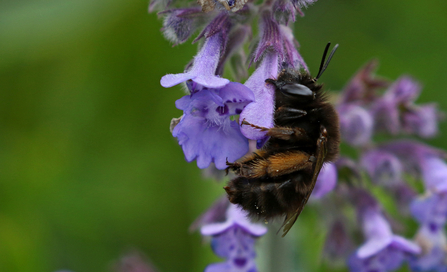On sunny and mild days towards the end of February and early March, you can usually see me staking out the lungwort and comfrey in the garden at Lower Smite Farm. This year is a little different - we're mostly all working from home (and Lower Smite Farm is currently closed) and the lungwort in my own garden is yet to flower. I already know that this year I won't be the first of a small group of friends who aim to be the first one to spot a hairy-footed flower bee.
Zooooooom
Hairy-footed flower bee (male) by Wendy Carter

Hairy-footed flower bee (male) by Wendy Carter
They're more commonly known as hairy-footed but I think they should be called feather-legged because the long hairs that give them their name actually extend all the way up the middle legs of the male bees (they they use them to stroke the female when mating). Males emerge a little before the females so that they’re full of energy when the females emerge.
You'll know if you spot one - they zoom. Unlike the bumbling bumblebees that they have a passing resemblance to, hairy-footed flower bees zoom about the place at high speed. They buzz quickly into a flower and appear to feed frantically before they zip off to the next flower; it makes them tricky creatures to capture in a photo.

Hairy-footed flower bee (female) by Wendy Carter
The males are relatively easy to spot with their bright gingery bodies and striking yellow/white faces (see photo at the top of the page). In contrast, females are black bundles of hair with orangey-red hind legs.
Hairy-footed flower bees are one of more than 200 species of solitary bee in the UK. Solitary bees construct individual nests in which to lay their eggs and then each female provisions her own eggs with food (pollen) for when they hatch. There is just one emergence a year - bees that you see this spring were laid last spring - when hatched, they ate their pollen before pupating and emerging as adults before the onset of winter. As I write this in late February, most will be sitting in their sealed cells waiting for the right moment. Their cells are pitcher-shaped and, in Worcestershire, they’re probably be in a wall with soft mortar joints; they don’t do any harm to the structure, they just exploit a hole that's already there.
If you'd like to give these zoomers a helping hand, why not plant some lungwort, comfrey, rosemary or borage flowers to see if you can attract them to your patch. Visit our wildlife gardening pages for more ideas on helping wildlife on your doorstep.

